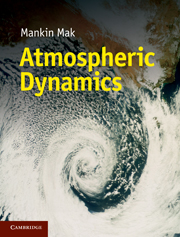Book contents
- Frontmatter
- Contents
- Preface
- 1 Fundamental concepts and physical laws
- 2 Basic approximations and elementary flows
- 3 Vorticity and potential vorticity dynamics
- 4 Friction and boundary layers
- 5 Fundamentals of wave dynamics
- 6 Quasi-geostrophic theory and two-layer model
- 7 Dynamic adjustment
- 8 Instability theories
- 9 Stationary planetary wave dynamics
- 10 Wave-mean flow interaction
- 11 Equilibration dynamics of baroclinic waves
- 12 Nongeostrophic dynamics
- Appendix: Mathematical tools
- References
- Index
- Plate section
9 - Stationary planetary wave dynamics
Published online by Cambridge University Press: 05 June 2012
- Frontmatter
- Contents
- Preface
- 1 Fundamental concepts and physical laws
- 2 Basic approximations and elementary flows
- 3 Vorticity and potential vorticity dynamics
- 4 Friction and boundary layers
- 5 Fundamentals of wave dynamics
- 6 Quasi-geostrophic theory and two-layer model
- 7 Dynamic adjustment
- 8 Instability theories
- 9 Stationary planetary wave dynamics
- 10 Wave-mean flow interaction
- 11 Equilibration dynamics of baroclinic waves
- 12 Nongeostrophic dynamics
- Appendix: Mathematical tools
- References
- Index
- Plate section
Summary
This chapter is concerned with the linear dynamics of stationary planetary waves. We begin by briefly showing some observed key characteristics of such a wave field in Section 9.1. Section 9.2 discusses the conceptual issues. We delineate the dynamical impacts of a zonal mean flow on the propagation of stationary planetary waves in Section 9.3. The excitation of a stationary wave field by a localized thermal forcing or by a localized orography is analyzed separately in Sections 9.4 and 9.5 with a simplest possible model. In each case, we delineate the impacts of the individual dynamical factors such as the beta-effect, the types of shear and the direction of the basic zonal flow on the forced wave field before we examine the combined influence of all of them in the various subsections. The relevance of this model is finally illustrated with a simulation study of the summer mean Asian monsoonal circulation in Section 9.6.
Observed characteristics of stationary planetary waves
The annual, seasonal or even monthly mean weather maps at different levels have a very broad wavy structure. Such a flow is stationary by definition, with respect to an annual, seasonal or monthly time scale respectively. Stationary planetary waves are considerably stronger in winter than in summer simply because the forcings that give rise to them are distinctly stronger. We illustrate the winter planetary wave field with the January mean flow over the northern hemisphere in 2003. The plots are constructed using the NCEP/NCAR Reanalysis Data set.
- Type
- Chapter
- Information
- Atmospheric Dynamics , pp. 309 - 349Publisher: Cambridge University PressPrint publication year: 2011



